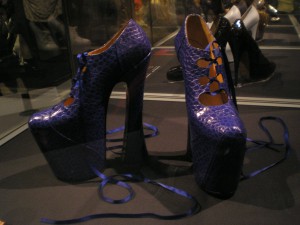
One of my friends recently spent her birthday in hospital and the following week in a wheelchair. Nope, she wasn’t drunk – she had yet to touch a drop. She was wearing some killer heels, and fell down a flight of stairs…
The long-term impacts of high heels have been well documented. Frequent high heel wearers can expect strains to their legs and back, bunions (Victoria Beckham is a famous sufferer), ingrown toenails – the list is long and slightly gross.
But researchers in Victoria, Australia have been looking at a more dramatic health problem caused by high heels – the falls, and the trips to A&E that result from them. Their results have been published in the Journal of Foot and Ankle Research, and make for pretty painful reading. They found that between 2006-2010 236 women(and 4 men) ended up in the emergency department due to in injuries related to the wearing of high heels. The authors excluded injuries related to the footwear belonging to a second party. For example, being stepped on by someone else wearing high heels (49 cases) or being assaulted with a high heel (16 cases).
Unsurprisingly, the most common time for these visits was Sunday morning – the morning after the night before, when the alcohol has worn off, and it becomes obvious that seeing a doctor about that injury is going to be necessary. Most injuries presented in the months of November, December and January, which in Australia is combined BBQ and Christmas party season, being the summer months. The most common injury the authors found was ankle sprain. This has led the authors to believe that “people who wear high heel footwear on weekends appear to be at higher risk for injury that leads to emergency department presentation.”
While some of us can recover with dignity after a fall, it’s a good idea to take preventative measures for these kind of injuries. Emma Thompson recently did the sensible thing and took her shoes off before the inevitable fall. And we’ve all seen those girls walking home heels in hand after they become too painful to walk in. You can even get tiny purse-sized folding flat shoes, to pre-empt the barefoot journey home.
Scientist Suze Kundu wears heels most days – she rarely falls over in them (no more often than most of us fall over in flats…). “For me, I’d fall over more if I was in flats, because I’m just not used to them,” she says “I hold myself differently in high heels, which is why I like wearing them. And being a bit taller doesn’t hurt.”
She’s even run the Race for Life in 3 inch heel boots – having run a marathon, she wanted to make the 5k a bit more of a challenge.

As a former ballet dancer, Suze wonders if there’s a link. Many dances are actually easier in heels because they force you to balance your weight differently – the best posture for some dances, like tango, or balboa for instance is to lean into your partner, and heels help to make this a bit more natural. And lindy hopper Sarah Breck has written about how wearing heels has improved her dancing.
But the origin of heels, was for just such a practical purpose, and while it’s mostly women wearing heels today, it was actually men that first started the practise of tottering around in stilettos. Mongolian cavalrymen used heels to stand up in their stirrups better, so they could shoot while on horseback. The heels also signified status – how highly ranked you were was quite literally signalled by how high you were! And when the style came to Europe, the exotic footwear was for men and women alike.
But the trend has become much more common for women than men – from ‘chopines’ of up to 20 inches high worn by 15-17th century Venetian courtesans, to today’s platform stilettos, all posing a potential health risk to those of us with less-than-perfect balance. The authors of the paper, Cylie Williams and Terry Haines, are clear that this an area deserving of more study.
“The foot health impact of fashion is not well understood in regards to the choices that younger women make about footwear. While women continue to make these shoe choices, more work is needed to better to understand why these choices are made and how to minimize any risks associated with their wear.”
So stay safe! And if you still can’t bring yourself to wear a sensible heel, at least be sensible in them.
Comments